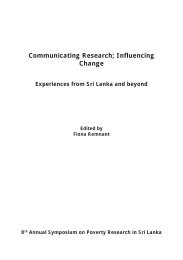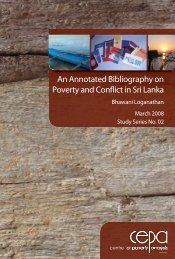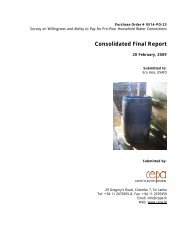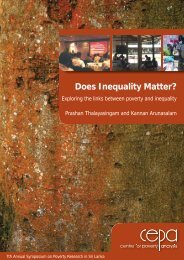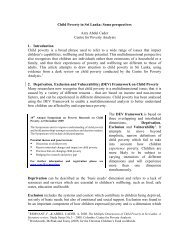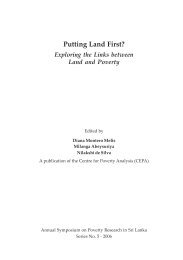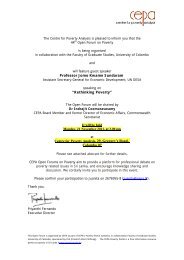Involuntary Displacement and Resettlement â Policy and ... - CEPA
Involuntary Displacement and Resettlement â Policy and ... - CEPA
Involuntary Displacement and Resettlement â Policy and ... - CEPA
- No tags were found...
You also want an ePaper? Increase the reach of your titles
YUMPU automatically turns print PDFs into web optimized ePapers that Google loves.
Most locals did not expect the IDPs to settle in Puttalam. The fear of losingthe resources available in the district by sharing them with a larger group ofpeople was the primary source of resentment <strong>and</strong> hostility. This situation wasfuelled by the competition for l<strong>and</strong>, livelihoods, government jobs, wages <strong>and</strong>services such as health <strong>and</strong> education. Competition to qualify for universityeducation is widely mentioned by many respondents. The district quotaavailable for Puttalam district is now shared between the locals <strong>and</strong> IDPs.The host community perceives this as a disadvantage because there isgreater competition for the same number of places.This competition has often been the source of conflict <strong>and</strong> violence.Resentment remains in Puttalam <strong>and</strong> is made worse by political figuresmanipulating the grievances of different groups for their own gain. Thesituation is further worsened by development projects that continue to seethe IDPs as the most vulnerable group in Puttalam <strong>and</strong> are not flexible oropen-minded in their approach to project implementation in the district.The perspective of IDPs about the issues of sharing resources is differentfrom what the locals feel. Given this present protracted displacementcondition, their perception centres around the ‘right to live’ anywhere in thecountry since there is no viable solution presented by the government withregard to the ‘resettlement’ or ‘integration’ of IDPs.2 Impacts of IDPs in PuttalamThe Making Peace - Keeping Peace project found many instances of negativeattitudes about each other among the hosts <strong>and</strong> IDPs. This was balanced inpart by the acknowledgement that the IDP’s impact was not always negative.People in the host community, for example, spoke of how the areas in whichthe IDPs settled had improved since they arrived, chiefly in the areas ofinfrastructure, service provision <strong>and</strong> enterprise development. The IDP’sinvestments in the area contributed to a more diverse <strong>and</strong> vibrant economicenvironment, providing employment opportunities for both IDPs <strong>and</strong> locals.The increased competition this presented to local traders, however, causedsome of them to view this as a negative development. A large extent offallow l<strong>and</strong> was purchased by IDPs who then began to invest <strong>and</strong> use itproductively, increasing their economic resources.117



